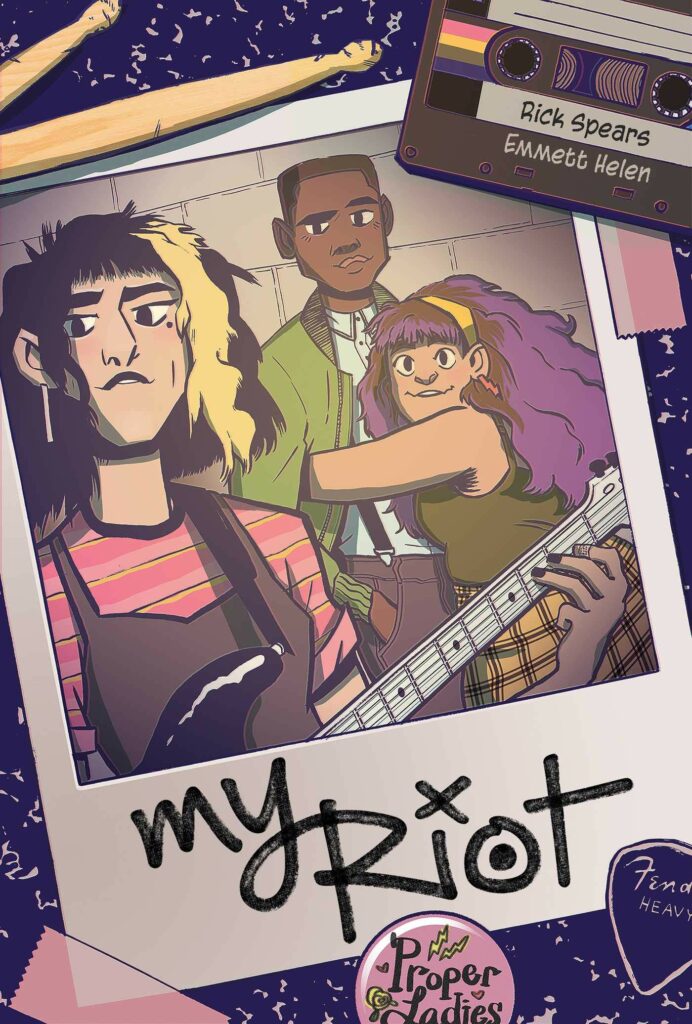Emmett Helen discusses how mistakes make your comics better
"The next time a page starts feeling stiff: Stop, put down the tools, and breathe."
The post below was kindly written by Emmett Helen, author and artist of My Riot.
Ever ink a page and feel that, somehow, despite the laws of nature that the many generous celestial beings have set forth to govern our universe, the drawings look worse than they did in the penciling phase?
Artists describe this as “losing the life” of their sketches. What’s happening is that all that gestural work, all that beautiful ambiguity, has been condensed to stark black lines placed meticulously where they ought to belong. Too meticulously. In all our panicking of putting all the lines in the right place, we manage to lose what gives drawings motion and spontaneity: motion and spontaneity.
Typically, the less someone is fussing over a piece, the more effortless it ends up looking. Veteran artists seem to just lay down these perfect strokes on the first try and it doesn’t make any damn sense. We’re told that it’s confidence! Earned through the decades. If we put in our 10,000 hours, we’ll get there. Eventually.
View this post on Instagram
It’s not totally wrong, but it’s also not totally right. Yes, there’s a confidence and quality that only years of experience can afford. But we’re looking at this from the wrong angle—they’re not necessarily getting lines exactly the way they envision them, they’re rolling with whatever they get. It’s a little like improv. Every line is a response to the one before it.
To cartoonists who work this way, there are no mistakes! Because there was no concrete intention and no rules. Absolutely delightful. I’m a perfectionist, so this is not my natural state. I didn’t learn how to roll with the punches until I had a huge deadline three weeks out and like thirty pages to ink. It also just happened to work for that assignment—like, who could blame me if My Riot, a book about teens playing punk music in dive bars, ended up looking shitty?
With everything technical thrown out the window, we can prioritize what makes comics good: Storytelling! Composition, acting, leading the eye. Ruler? I hardly know her.
This might seem a little amorphous. It totally is, and that’s because every cartoonist nests their priorities differently. I’m a guy that spends ninety percent of a page in the thumbs, kind of skipping pencils? And treats ink like a drawing tool. This works for me because it ensures my inkwork isn’t just tracing—and that happy accidents are happening. Is this character constantly off-model? Yep. Is she identifiable anyway? I hope so. Does that totally unregulated whip of a line make her hair look like it’s moving, really moving? Hell yeah.
Not every comic book is about punk band hijinks, so a caution-to-the-wind approach isn’t going to work for everything. But start there—storytelling first, and if it works, aesthetics and technicalities later, maybe, if it sounds like fun.
View this post on Instagram
Perspective grids are an excellent time-saver when drawing digitally, but can sometimes work against a shot that needs drama. We might also get to pencils and realize that the perfect composition we had in our breakdowns like…doesn’t work…scientifically. So maybe we can fudge it, because that perfect composition, how it frames the subject and leads the eye through the page, is way more important than some dumb science. And easier, too! Proportions don’t have to be photorealistic; poses can be a little wonky; and lines don’t have to be straight. All of it, even the stuff that doesn’t look good, is a tiny sacrifice for pages full of life and less anxiety. (As an aside—this is how style happens. Experimentation, lots of drawing, and also not caring about style.)
Of course, some technical stuff can’t be compromised without breaking immersion—or, reminding our audience that this is fake and a comic book—so tread wisely. Panel shapes and gutters, lettering standards, and page formats don’t invite experimentation unless it’s intentional. It’s like building a house—don’t screw with the foundation, but hang anything on the walls. The more earnest, the more charming.
The other caveat is that this approach totally doesn’t work for every artist. Some folks work best with tight pencils, some get really kinetic pieces out of patient and deliberate inking. That is an invaluable skillet, and one I probably won’t ever figure out. They get energy without physics holding the reigns.
View this post on Instagram
When we can get a handle on the rules and then ignore a few of them for something spontaneous, what occurs is lovely, unforgettable things. A classic suit, but in powder blue. Edgar Wright movies. Lobster mac and cheese. Riot grrrl music. Shrek ketchup (debatable.) The established rules make comics good, but breaking the right ones is what makes a comic excellent.
The next time a page starts feeling stiff: Stop, put down the tools, and breathe. Where’s the apprehension coming from? Maybe it’s my first big book and I’m scared I’ll blow it. Maybe I need more practice before I draw this metric ton of horses. Is it something much more serious—like a mental health issue? Have I taken care of my basic needs? Whatever can be addressed, that takes priority. For me, my drawing is a direct reflection of my health. When the drawing’s feeling bad, I probably felt bad to begin with.
So yeah, making mistakes—breaking the rules, being spontaneous, whatever you want to call it—is a great way to make great comics. But the most excellent part is that it makes the process way more enjoyable. That’s why we’re here in the first place! We really like drawing. If more fun can be had with making comics (or regained from long ago), that’s a way grander victory than having flawless art.

Get your copy of My Riot by Rick Spears and Emmett Helen in the UK & US.


